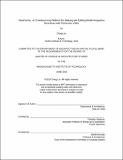| dc.contributor.advisor | Takehiko Nagakura. | en_US |
| dc.contributor.author | Liu, Chang, S.M. Massachusetts Institute of Technology | en_US |
| dc.contributor.other | Massachusetts Institute of Technology. Department of Architecture. | en_US |
| dc.date.accessioned | 2018-10-15T18:37:16Z | |
| dc.date.available | 2018-10-15T18:37:16Z | |
| dc.date.copyright | 2018 | en_US |
| dc.date.issued | 2018 | en_US |
| dc.identifier.uri | http://hdl.handle.net/1721.1/118489 | |
| dc.description | Thesis: S.M. in Architecture Studies, Massachusetts Institute of Technology, Department of Architecture, 2018. | en_US |
| dc.description | This electronic version was submitted by the student author. The certified thesis is available in the Institute Archives and Special Collections. | en_US |
| dc.description | Cataloged from student-submitted PDF version of thesis. | en_US |
| dc.description | Includes bibliographical references (pages 49-50). | en_US |
| dc.description.abstract | Traditional storytelling methods have been developed and expanded with the emergence of new media products. One powerful contemporary medium, panoramic video, helps to present and provide understanding of stories that occur in a spatial environment and their related context. However, telling a story with a panoramic video can make it challenging for storytellers to share their perspectives given that the whole landscape is presented to the audience without any frames. The aim of this research is to explore the potential of making multi-perspective panoramic video narratives. As low-cost panoramic cameras become prevalent among non-professional consumers, an easy-to-use panoramic video editing tool is required for emerging storytellers. With this tool, it is possible to build a crowdsourcing community that helps create multi-perspective narratives with panoramic videos. This thesis introduces PanoFrame, a crowdsourcing platform for making and editing multi-perspective narratives with panoramic videos. The main editing purpose is to specify a sequence for a panoramic video's default viewing angle, field of view, and playback rate in the runtime. Three experiments were conducted using different groups of participants to test how people create, understand, and interact with a panoramic video story in the proposed tool. The results reveal that PanoFrame enables storytellers to work collaboratively and create multiple narratives from a panoramic video, and the generated panoramic video narratives are also more attractive to audiences than the raw video. PanoFrame can serve as a computer-aided design tool that lowers the barrier to designing narratives from panoramic videos. It can also be used as the basis for developing a crowdsourced platform for building an open-sourced panoramic video-sharing community. Future development will entail deploying computer vision algorithms to automate part of the storytelling process with panoramic video using data collected from the community. | en_US |
| dc.description.statementofresponsibility | by Chang Liu. | en_US |
| dc.format.extent | 50 pages | en_US |
| dc.language.iso | eng | en_US |
| dc.publisher | Massachusetts Institute of Technology | en_US |
| dc.rights | MIT theses are protected by copyright. They may be viewed, downloaded, or printed from this source but further reproduction or distribution in any format is prohibited without written permission. | en_US |
| dc.rights.uri | http://dspace.mit.edu/handle/1721.1/7582 | en_US |
| dc.subject | Architecture. | en_US |
| dc.title | PanoFrame : a crowdsourcing platform for making and editing multi-perspective narratives with panoramic video | en_US |
| dc.title.alternative | Crowdsourcing platform for making and editing multi-perspective narratives with panoramic video | en_US |
| dc.type | Thesis | en_US |
| dc.description.degree | S.M. in Architecture Studies | en_US |
| dc.contributor.department | Massachusetts Institute of Technology. Department of Architecture | |
| dc.identifier.oclc | 1054786736 | en_US |
